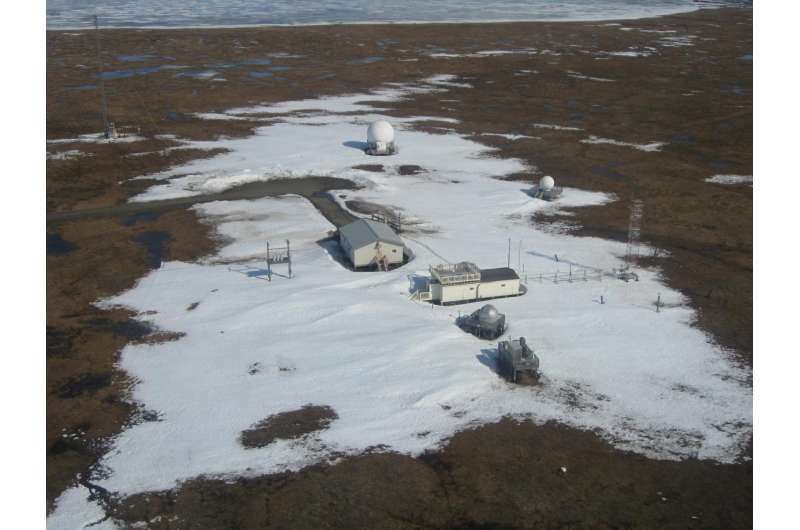As Alaska warms, methane emissions appear stable, study finds

Analysis of nearly three decades of air samples from Alaska's North Slope shows little change in long-term methane emissions despite significant Arctic warming over that time period, according to new research published in Geophysical Research Letters, a journal of the American Geophysical Union.
Scientists estimate that Arctic permafrost, a thick layer of frozen soil that encircles the globe, contains two and a half times as much carbon as has been emitted since the dawn of the Industrial Revolution. As the region warms, this carbon will be released from the permafrost's icy grip.
Scientists need to know where that carbon will go and what form it will take. This has become more critical since the Arctic is warming faster than other regions of Earth, with corresponding losses in sea ice coverage. Some models suggest that a portion of that carbon will be released as methane, a potent greenhouse gas that has almost 28 times the warming influence of carbon dioxide over a 100-year timescale.
In the new study, researchers from the Cooperative Institute for Research in Environmental Sciences (CIRES) at the University of Colorado Boulder, NOAA, NASA and other university partners examined 29 years of continuous, precision measurements of atmospheric methane and other gases from the NOAA Barrow Atmospheric Baseline Observatory, which is part of NOAA's Global Greenhouse Gas Reference Network.
"There has been a huge increase in Arctic warming, and while we do see spikes in methane due to short-term temperature changes, we're not seeing a long-term change in methane levels," said Colm Sweeney, a CIRES scientist working at NOAA's Earth System Research Laboratory in Boulder and lead author of the new study.
But that doesn't mean thawing permafrost isn't releasing carbon, Sweeney said. "It's happening. It just isn't showing up as methane."
Arctic permafrost contains an estimated 1,000 gigatons (1,000 billion tons) of carbon. Besides being emitted as methane, carbon stored in thawing permafrost could be released into the atmosphere as carbon dioxide, carried off by meltwater into river systems, or taken up by vegetation as plant communities expand their range.
The team supplemented the continuous measurements from the Barrow observatory with measurements made by a five-year, NASA-led airborne campaign known as CARVE (Carbon in Arctic Reservoirs Vulnerability Experiment), which helped them nail down methane's seasonal and long-term trends in the region. They saw an uptick in methane levels in late fall and winter, but no long-term signal across Alaska's North Slope.
"Bacteria that produce methane and bacteria that consume methane will both become more active as temperatures get warmer," said Steven Wofsy of Harvard University and co-author of the study. "Our study suggests that over the past 30 years, these processes have balanced out in the study area."
The researchers conclude that observed short-term methane spikes from the Arctic will likely have little impact on global atmospheric methane levels in the long-term.
This finding is critical to science's understanding of how the Arctic is responding to the unprecedented disruption of its climate and the degradation of permafrost. The lack of significant long-term trends indicates that processes regulating North Slope methane emissions need more study.
With little observed change in methane emissions, researchers are further examining the Barrow observatory's dataset for signs that the permafrost has been emitting carbon dioxide, by far the most significant of the greenhouse gasses, as it may be more affected by large temperature changes (and by extension, melting permafrost) in the Arctic. The Barrow dataset features in an upcoming paper on Arctic carbon dioxide levels co-authored by Sweeney. Several other research efforts are also examining this hypothesis.
More information: Colm Sweeney et al, No significant increase in long-term CHemissions on North Slope of Alaska despite significant increase in air temperature, Geophysical Research Letters (2016). DOI: 10.1002/2016GL069292
Journal information: Geophysical Research Letters
Provided by American Geophysical Union





















